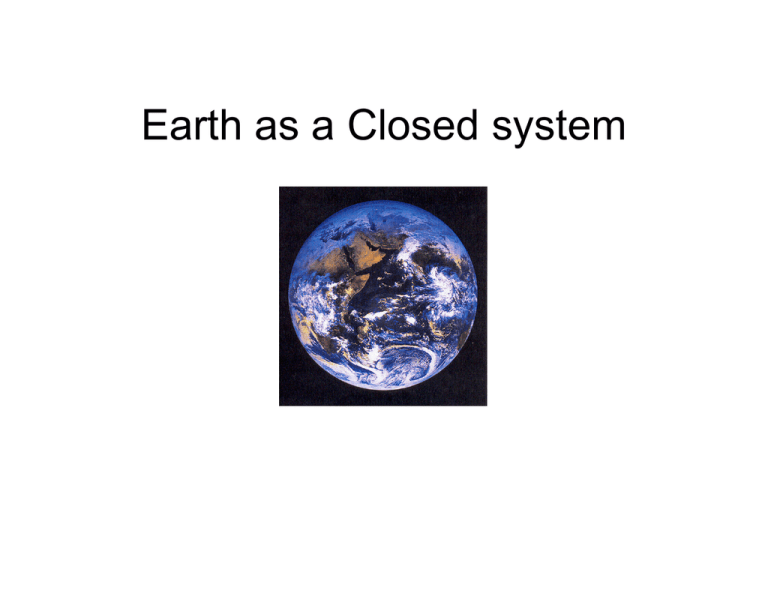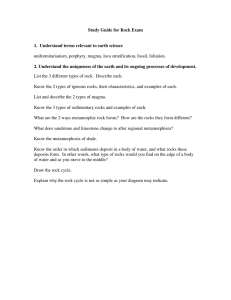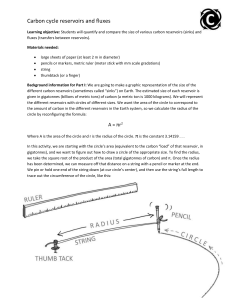Earth as a Closed system
advertisement

Earth as a Closed system The Earth is a closed system where materials cycle between the lithosphere (Earth), atmosphere, hydrosphere, and biosphere What does it mean to be a “system”? What does it mean to be a “closed” system? A “system” • Definitions: “An assemblage or combination of things or parts forming a complex whole” “A coordinated complex scheme” “An assemblage of parts concerned with the same function” The Earth as a system: the processes operating on Earth interact with one another; changes in one process, such as volcanic activity, result in changes in another, such as atmospheric composition Types of systems: Ex: a beaker of water with sunlight Isolated: no matter or energy enters or leaves Closed: energy enters and leaves but material does not Open: both energy and matter enter and leave The Earth is a closed system: energy from sunlight enters and “no” matter enters or leaves (except for the rare meteorite) Earth as a closed system Material flows between reservoirs or sinks along pathways, or fluxes. Examples: Water vapor in the atmosphere condenses and falls as rain and breaks down rocks. Ocean water evaporates into the atmosphere. Volcanoes erupt and spew water vapor into the atmosphere Any change in one reservoir creates change in others!!!!!! No part of spaceship Earth operates in isolation! Humans, with their narrow time perspective, often don’t see the “ripple effect” that changes in one reservoir (like atmospheric CO2 levels) have on the rest of the closed system….”feedbacks” What are the rates by which these processes happen? Note the scale on this diagram: there is a 10x increase from one interval to another across the bottom. Within the Earth system, there is also cycling in each of the reservoirs. For example, cycling in the lithospheric, or rock, cycle: There are 3 types of reservoirs in the lithospheric cycle: igneous, metamorphic and sedimentary rocks. Various processes, such as burial and melting, volcanism, or erosion move this material from one reservoir to another. THE major process that drives the rock cycle is “plate tectonics” - the idea that the surface of the Earth is divided into several rigid slabs that move around in response to heat flow within the Earth. The major plates of today’s world Heat flow from the interior The second most important process which drives the rock cycle is energy from the Sun, which is responsible for precipitation and heat and the breakdown of rocks In this photo of the Grand Canyon we can see the Colorado River transporting sediment and dissolved solids: modern processes in the current rock cycle. We can also see the walls of the Grand Canyon, which consist of 1000’s of feet of sediment that accumulated by these same processes millions of years ago. Although the processes which have occurred throughout the past 2.5 billion years of Earth history have remained the same, the rates at which the processes, or fluxes, occur are highly variable: some are instantaneous and others are extremely slow! Humans occupy the extremely thin interface between two active heat sources that are driving physical and chemical reactions These reactions occur at rates that allow many humans to ignore them, but there cumulative record is preserved in rocks How do geologists reconstruct past events in the earth? • Examine the picture and make a list of all the interpretation s you can make about what happened here. The Principle of Uniformitarianism • The Principle of Uniformitarianism says that the processes that we see on Earth today have happened in the past. • The P of U doesn’t say anything about the rates at which processes occur • Caveats to the P of U: the processes occur deep within the Earth and we don’t see them; they occur at very slow rates and it’s not obvious they are happening; the earliest Earth had not yet achieved an equilibrium state - it wasn’t always so (the Archean Eon) Application of the Principle of Uniformitarianism.. Symmetrical ripples with bifurcating crestlines on a modern beach The same ripple shapes in a 400 million year old sandstone…we interpret that the rippled sand formed on a beach



